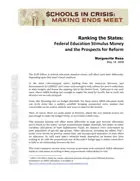This brief presents projections of changes in state K-12 education spending, amidst both state revenue gaps and the addition of ARRA funds. The idea is to rank order states according to how much budget gaps and stimulus funds are likely to affect state education spending.
This analysis relies on the most current state projections of budget shortfalls (as reported by the Center for Budget and Policy Priorities), ARRA allocations for education by state, and 2009 state education budgets. The analysis does not take into account any of the decisions that state lawmakers are making on their budgets. Rather, it projects spending as if revenue gaps are first applied proportionately to education during 2008-09 and 2009-10, and then as if 70% of all education ARRA funds are applied to K-12 education during the 2008-09 and 2009-10 school years.
The numbers don’t reflect ongoing changes made in states, but rather their vulnerability to cuts as a result of these two changes (revenue gaps and stimulus funds).
The methods used invoke some important caveats for understanding the analysis:
- The analysis doesn’t reflect actual budgetary decisions made by the policymakers in different states.
- The analysis compares the projected total 2008-09 and 2009-10 spending relative to what would have happened if states had held spending constant at the originally budgeted 2008-09 amounts.
- This analysis projects changes in state education spending only when ARRA funds are added in (and thereby doesn’t include local spending).
Given these assumptions, the analysis should be understood as a relative ranking of states by projected changes in state spending on education, given current revenue projections and published ARRA allocations.
This Rapid Response analysis is the third in the “Schools in Crisis: Making Ends Meet” series.




